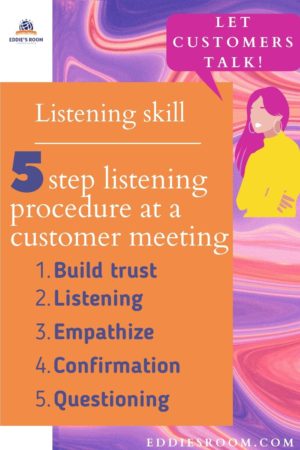As listening is the core part of communication at a customer meeting, I would like to summarize the procedure of how we build relationships with customers in addition to listening.
1. Build trust
Pacing
Pacing is a technique to control speaking speed and connects us to customers. And pacing can be applied to any kind of topic.
How do we control speaking speed?
If the customer talks fast you talk fast and if the customer talks slow, you talk slow. That’s pacing. It’s an easy and useful technique. Pacing intends to make customers comfortable to communicate.
Especially when we are nervous, we tend to speak fast because our hearts beat faster than usual. In that case, pacing works well to make ourselves calm down and adjust speaking speed to customers’. On the other hand, if your speaking speed is different from customers, it might not be comfortable for customers.
Mirroring
Mirroring is a technique to respond to a customer’s words and body language and can be applied anytime. Mirroring includes body language such as arms crossed, legs crossed, standing, sitting, leaning forward, leaning back, or verbal communication such as using the same kind of metaphor, using the same words. So we can say the pacing is a kind of mirroring.
Here I want to say that mirroring is not copying the action of customers. When you were a kid, did you imitate the movement of your friend? If you have experience, you know it makes others uncomfortable and irritated. So we should avoid this. The bottom line is mirroring should be done naturally.
2. Listening
Listening to customers might be easier than listening to our loved ones. I want to pick up some pitfalls that we should not do during listening to customers.
Don’t interrupt
I know you want to talk. Everyone wants to talk. Me too. But don’t interrupt it when customers talk. Let customers talk and let them finish their talk. In the opposite position, you don’t want to be interrupted when you talk, right?
Don’t argue
If customers say something wrong, don’t argue it. If you want to go to the same goal with customers, there is no meaning to object to them.
Don’t think about what you will talk about next
When customers are talking, please focus on their talk. If you think about what you will talk about next, you may lose the point of their talk. If you lose the point, your customers will not listen to you and the connection and trust you build will be broken.
3. Empathize
Acknowledge customer feeling
We can show our feeling about customers’ talk. So we have to listen to understand customer feeling correctly. That is basis of empathize.
For example, we can say
“Oh, you must be super busy.” or
“That looks really challenging.”
It’s not difficult and you may usually do this. However, sometimes we face difficulty in how we express our empathy. If you don’t know what to say, you can say so,
“Oh, it’s a shame that the accident happened. I don’t know what to say. “
4. Confirm
Then the next step is confirmation. After we listen to everything, we can repeat what we hear in our words. Also, we can restate the summary of their talk.
And we can ask if our understanding is correct, such as
“What I hear is …” or “You are saying …”
5. Questioning
After confirmation, we can ask follow-up questions to understand more. Here are some tips for questioning. Also please check my previous post How do you prepare for small talk chat.
- No Bias
- Don’t stick with your assumption
- Don’t be afraid of silence (Give them time to think about your question.)
- Don’t use too much”Why”.
- Ask a specific and abstract question
- Ask a past – present – future question
Thank you for reading this post.
Listening is the key to success in customer meetings!
Let them talk and empathize it then show your understanding through confirmation and develop with questions.


